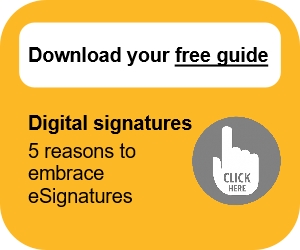ESignature
eSignatures are digital methods used to sign documents electronically. They are legally recognised and can be used to authenticate and validate contracts, agreements, and other important documents. They are a legal equivalent to a handwritten signature when certain conditions are met.
Types of eSignatures include:
- Simple Electronic Signatures (SES): Basic electronic signatures such as a scanned image of a handwritten signature or a typed name at the end of an email.
- Advanced Electronic Signatures (AES): More secure, involving methods that uniquely link the signatory to the signature, capable of identifying the signatory, and created using electronic signature creation data that the signatory can use under their sole control.
- Qualified Electronic Signatures (QES): The highest level of security, created using a qualified electronic signature creation device and based on a qualified certificate for electronic signatures. QES is legally equivalent to a handwritten signature across the EU and UK.
eSignatures are governed by the Electronic Communications Act 2000 and the EU’s eIDAS (Electronic Identification, Authentication, and Trust Services) regulation, which continues to influence UK law post-Brexit. These laws ensure that eSignatures are legally binding and enforceable.
In the construction industry, eSignatures might be used for:
- Construction contracts, including agreements between contractors, subcontractors, suppliers, and clients, can be signed electronically.
- Documents related to project management, such as change orders, site instructions, and progress reports, can be signed digitally.
- Applications and approvals for planning permissions, environmental permits, and other regulatory requirements can be processed more efficiently with eSignatures.
- Financial transactions, including invoices, payment approvals, and payroll documents, can be streamlined using electronic signatures.
eSignatures significantly reduce the time required to sign and process documents. Traditional methods involving physical signatures can be slow due to logistics and the need for in-person meetings. eSignatures enable instant signing and distribution, speeding up project timelines.
The use of eSignatures also eliminates costs associated with printing, mailing, and storing physical documents. It also reduces the need for travel, thereby cutting down on expenses related to meetings and site visits.
eSignatures often come with built-in security features such as encryption, authentication, and audit trails. These features ensure that documents are signed by the intended parties and have not been tampered with, which is crucial for maintaining the integrity of contracts and compliance with legal standards.
eSignatures integrate seamlessly with digital document management systems, allowing for better organisation, storage, and retrieval of documents. This integration helps prevent loss or misplacement of important documents and ensures easy access for future reference.
Using eSignatures can also help mitigate risks associated with fraud, unauthorised alterations, and disputes over authenticity. The ability to track and audit every step of the signing process provides a clear record that can be used in case of legal or contractual disputes.
[edit] Related articles on Designing Buildings
BIM Directory
[edit] Building Information Modelling (BIM)
[edit] Information Requirements
Employer's Information Requirements (EIR)
Organisational Information Requirements (OIR)
Asset Information Requirements (AIR)
[edit] Information Models
Project Information Model (PIM)
[edit] Collaborative Practices
Industry Foundation Classes (IFC)







